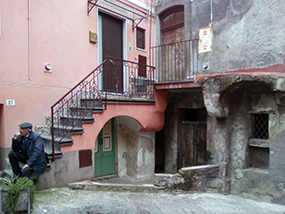The inner center
The small streets and the stairs An important cultural and
tourist heritage to be safeguarded
 The old city center still keeps unchanged the ancient town planning structure, still readable in the original weft of streets and, above all, the typical architectural compositions. The old city center still keeps unchanged the ancient town planning structure, still readable in the original weft of streets and, above all, the typical architectural compositions. The houses, laid one on top of the other, the small streets pressed together and sloping, the little lanes and the numerous courtyards, the steps, the paving in lava stone and the many testimonies left by the stone cutters of Bronte on the façades, in the portals, in the windows, still show intact the remains of an ancient civilization brontese.
The modest, quiet, silent social life in Bronte takes place mainly
along Corso Umberto ("a chiazza"), the
main street that cuts the town in two.
Together with Via Santi (one of the longest streets that surrounds the town
in the upper part), Corso Umberto, with its characteristic squared lava
stone paving stones ("i baràti"), is the main street of the
town.
 Once
called "Via Nazionale per Randazzo", it is the first street you meet coming
to Bronte from Catania. It is the "living room" of the Etna town, the street
of parades, meetings and the usual stroll of young and old. Once
called "Via Nazionale per Randazzo", it is the first street you meet coming
to Bronte from Catania. It is the "living room" of the Etna town, the street
of parades, meetings and the usual stroll of young and old.
It begins immediately after the "Scialandro"
and, with its winding path and the characteristic lava paving stones, it
provides an elegant backdrop to many churches and the most important
buildings in the center.
From Corso Umberto, like in a thick spider web, branch off the winding
narrow streets that surround the churches and palaces of Bronte and the
continuous stairways and narrow alleys that open onto large courtyards. A
true labyrinth that encloses the ancient peasant agglomeration of Bronte.
The Corso ends, through the massive and ever-present structure of the
Real Capizzi College and the large open space
of Piazza Spedalieri,  which
has always been the area of celebrations, demonstrations and political
meetings, in front of the church and the convent of the Capuchin fathers. which
has always been the area of celebrations, demonstrations and political
meetings, in front of the church and the convent of the Capuchin fathers.
Visiting the old city center of Bronte you have glimpses of
great beauty and charm. The town, interspersed with continuous and varied
stairways, is marked by narrow and winding streets,
on which numerous churches stand and where the remains of the ancient
peasant civilization that has always distinguished it are still intact.
The most important ancient buildings and palaces still preserve intact the
ancient and elegant frameworks and the elements of particular interest in
lava stone (the material used predominantly over the centuries).
|  The old city center still keeps unchanged the ancient town planning structure, still readable in the original weft of streets and, above all, the typical architectural compositions.
The old city center still keeps unchanged the ancient town planning structure, still readable in the original weft of streets and, above all, the typical architectural compositions.
 Once
called "Via Nazionale per Randazzo", it is the first street you meet coming
to Bronte from Catania. It is the "living room" of the Etna town, the street
of parades, meetings and the usual stroll of young and old.
Once
called "Via Nazionale per Randazzo", it is the first street you meet coming
to Bronte from Catania. It is the "living room" of the Etna town, the street
of parades, meetings and the usual stroll of young and old. which
has always been the area of celebrations, demonstrations and political
meetings, in front of the church and the convent of the Capuchin fathers.
which
has always been the area of celebrations, demonstrations and political
meetings, in front of the church and the convent of the Capuchin fathers.






















 In the center small streets, still adapted to an agricultural economy, and not, as yet, invested by the rhythm of industrial life, everything preserve an aspect by now unknown to city life.
In the center small streets, still adapted to an agricultural economy, and not, as yet, invested by the rhythm of industrial life, everything preserve an aspect by now unknown to city life.





